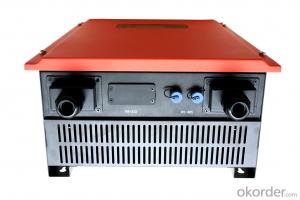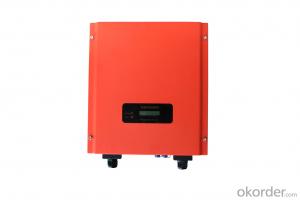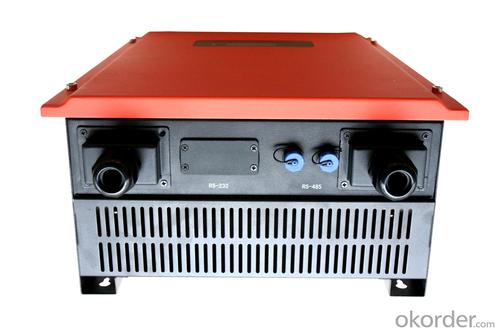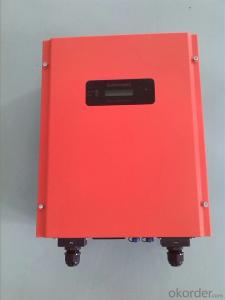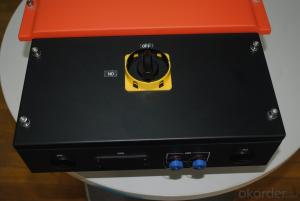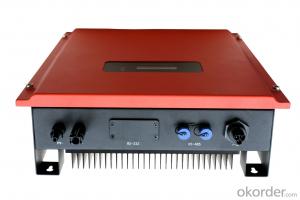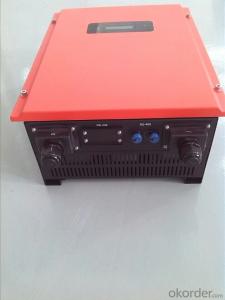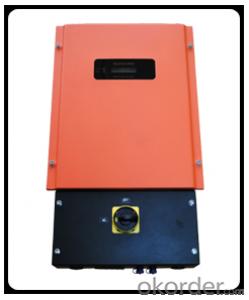100kW Solar Inverter Sunteams 4000-5000(US) ETL
- Loading Port:
- Shanghai
- Payment Terms:
- TT OR LC
- Min Order Qty:
- 5 watt
- Supply Capability:
- 3000 watt/month
OKorder Service Pledge
OKorder Financial Service
You Might Also Like
The Sunteams (US) 1500 ~5000 series isapplicable to various rooftops and small scale photovoltaic grid connected power plants. Their nominal output powers are 1.5 kW, 2 kW, 2.5 kW, 3 kW, 4 kW and 5kW respectivelywith Certificate ETL (220V/60HZ).
This series is transformerless and has a wide range of MPPT input voltage. Itsmaximum conversion efficiency and MPPT tracking accuracy reach 97.6 % and 99.5% respectively. The maximum DC voltage reaches 550 V. Its multilingualLCD display facilitates easy operation. It has waterproof direct plug interminals. It has overvoltage, islanding, short circuit, overloading andoverheating protection functions. Its IP65 protection degree will ensure itruns well in various tough environments.
These units are available with or without wirebox.
UL certified
■ For countries with UL certification (UL 1741 / IEEE 1547)
Efficient
■ The CEC efficiency of the inverter can reach 95.0 %-97.5 %
■ Transformerless desi
Simple
■ ‘Plug and play’connection for easy installation and maintenance
■ Designed for hanging with simple and easy installation
■ Fanless cooling concept
Communicative
■ RS232/RS485 interfaces as standard
■ Optional Bluetooth technology
- Q: Can a solar inverter be used with a solar-powered lighting system?
- Yes, a solar inverter can be used with a solar-powered lighting system. The solar inverter is responsible for converting the direct current (DC) generated by the solar panels into alternating current (AC) that can be used to power the lighting system. It ensures efficient energy conversion and ensures compatibility between the solar panels and lighting system.
- Q: How do you choose the right size of solar inverter for a solar power system?
- When choosing the right size of solar inverter for a solar power system, it is important to consider the maximum power output of your solar panels. The inverter should have a capacity that matches or slightly exceeds the maximum power output of the panels to ensure optimal performance. Additionally, the inverter's voltage and current ratings should be compatible with the solar panels and other system components. Consulting with a solar professional or installer can help determine the appropriate size of inverter based on your specific system requirements.
- Q: What is the role of an isolation transformer in a solar inverter?
- The role of an isolation transformer in a solar inverter is to provide electrical isolation and safety. It separates the input and output circuits, preventing any direct connection between them. This isolation helps protect the solar inverter and connected devices from electrical faults, surges, and other potential hazards. Additionally, it can minimize the risk of electrical shocks and reduce electromagnetic interference.
- Q: How does a solar inverter handle grid synchronization during startup?
- A solar inverter handles grid synchronization during startup by employing advanced control algorithms. It continuously monitors the grid voltage and frequency, aligns itself with the grid parameters, and gradually increases its output power to match the grid. This synchronization process ensures that the solar inverter seamlessly integrates with the grid and provides stable and synchronized power generation.
- Q: How does a solar inverter ensure safety during maintenance?
- A solar inverter ensures safety during maintenance by automatically disconnecting the system from the grid and de-energizing the circuits. This prevents any potential electrical shocks or accidents while the maintenance personnel work on the system.
- Q: How does a grid-tied solar inverter function?
- A grid-tied solar inverter functions by converting the direct current (DC) produced by solar panels into usable alternating current (AC) that can be fed into the electrical grid. This inverter synchronizes the frequency and voltage of the generated electricity with that of the grid, allowing for seamless integration and distribution of solar power to homes and businesses. Additionally, it continuously monitors the grid voltage and shuts down in the event of a power outage to ensure safety and prevent back-feeding.
- Q: How does a solar inverter handle variations in solar panel degradation over time?
- A solar inverter is designed to handle variations in solar panel degradation over time by continuously monitoring the output of the solar panels and adjusting its operation accordingly. It helps to optimize the power generation by compensating for any decrease in panel efficiency due to degradation. This is achieved through advanced algorithms and maximum power point tracking (MPPT) technology, which ensures that the inverter operates at the optimal voltage and current levels to extract the maximum power from the panels, even as their performance degrades over time.
- Q: What is the role of a solar inverter in power quality management?
- The role of a solar inverter in power quality management is to convert the direct current (DC) generated by solar panels into alternating current (AC) that can be used to power electrical devices. In addition to this basic function, solar inverters also play a crucial role in managing power quality by ensuring a stable and consistent supply of electricity. They help regulate voltage levels, minimize voltage fluctuations, and mitigate harmonic distortions, thus improving the overall quality and reliability of the power generated from solar energy.
- Q: What is the maximum AC output power of a solar inverter?
- The maximum AC output power of a solar inverter depends on its specifications and capacity. It can range from a few hundred watts for small residential inverters to several megawatts for large-scale commercial or utility-grade inverters.
- Q: Can a solar inverter be used with a solar-powered telecommunications system?
- Yes, a solar inverter can be used with a solar-powered telecommunications system. A solar inverter is an essential component of a solar-powered system as it converts the direct current (DC) generated by solar panels into alternating current (AC) that can be used to power various electrical devices, including telecommunications equipment. By using a solar inverter, the solar-generated electricity can be efficiently utilized to run a telecommunications system, making it a sustainable and environmentally-friendly solution.
Send your message to us
100kW Solar Inverter Sunteams 4000-5000(US) ETL
- Loading Port:
- Shanghai
- Payment Terms:
- TT OR LC
- Min Order Qty:
- 5 watt
- Supply Capability:
- 3000 watt/month
OKorder Service Pledge
OKorder Financial Service
Similar products
Hot products
Hot Searches
Related keywords
